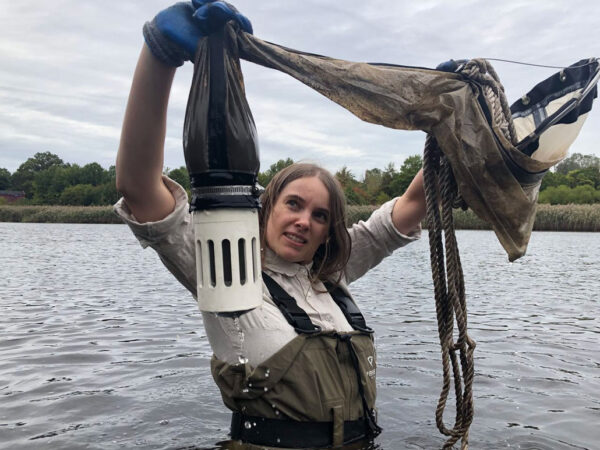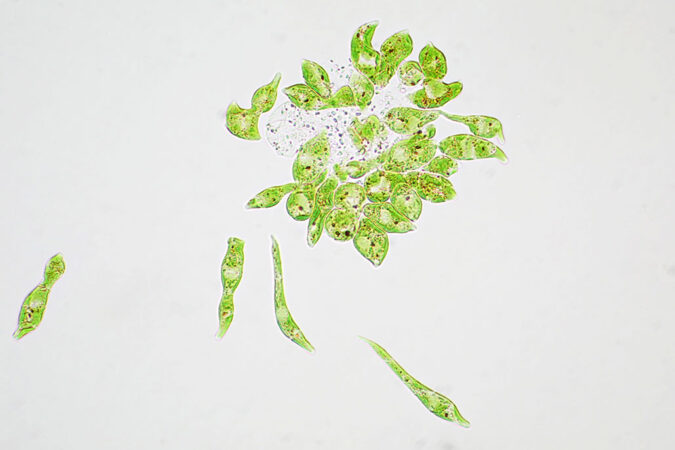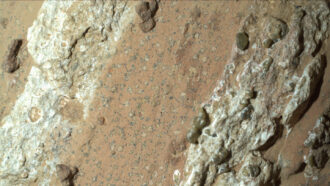Under the microscope, this biologist sees a tiny jungle
Sally Warring studies tiny life forms called protists — and captures them on camera

Biologist Sally Warring (pictured) is fascinated by protists and other microscopic life forms found in pond water.
Shawn Simpson
To Sally Warring, protists are an absolutely underrated type of wildlife.
“Protists are very charismatic and interesting,” says Warring, who studies these creatures at the Earlham Institute in Norwich, England. Among this richly diverse group of mostly single-celled eukaryotes (creatures whose DNA is packed in a nucleus), some are hunters and others prey. Some live in colonies, others alone. Some even have mating rituals or build themselves tiny structures to live in.

“There’s all this stuff going on that we usually associate with more complex animals,” Warring says. “It’s just not as well-studied because it’s harder to study.”
Warring’s research investigates the genetic blueprints, or genomes, of protists. “From the genomes, we can get information about what these organisms are and how they live — what they need to eat … if they secrete things into the environment, that kind of information,” Warring says. That could help explore more than the largely uncharted biodiversity of protists. It could put more familiar types of life into better context, too.
“Protists make up most of eukaryotic diversity,” Warring says. “So if we want to understand how different eukaryotic groups evolved — including animals, plants, fungi and important parasites — then we need to understand what’s going on in protists.”
In this interview, Warring shares reflections on her experiences with Science News Explores. (This interview has been edited for content and readability.)
What sparked your interest in protists?

During my undergrad, I randomly took a course on protists, and I just was blown away. We got to look at different protists through the microscopes, and I got to see organisms such as Volvox and Paramecium and amoebas.
I’d never thought about these organisms before. I didn’t know anything about them. And I couldn’t believe how much complexity and behavior and lifestyle was exhibited by organisms that were only one-cell big. Or, in the case of Volvox, a colony of cells.
What’s your favorite protist?
I do like Volvox, mainly because it’s one of the ones I first saw and is just really beautiful. It’s big enough that you can see it with the naked eye, because it’s a colony. If you find it blooming in a pond, you can just hold that water up to the light, and you’ll be able to see them all moving around.
I now work on a group of protists called the Euglenozoa, which are also up there in terms of favorites. They come in a range of colors and sizes, and they do all sorts of different things. One of my favorites is called Phacus. It looks like a falling leaf when it moves around. It’s really beautiful.

How did your Instagram Pondlife start?
I started it during my Ph.D., after a conversation I had with the man I’m now married to. He was asking me about my research on protists and asked me, “Why are you even interested in these things?” And I was saying, “They look amazing, and they do all these cool behaviors.” He said, “It sounds like they would make great television.”
After that, I spent some time figuring out how to do the photography with my iPhone through a microscope. And I started going out and collecting samples around New York City, putting them under the microscope and just filming things that I liked.
How do you foster creativity?
I go and sit at the microscope and just spend some time looking at things, if I need a break from the computational work that I do. I also find talking to colleagues really valuable.
If I’m working on a problem that’s giving me trouble, sometimes I just get up and go for a little walk outside or even around the building. Sometimes the project’s just kind of turning over in my head, and an idea comes to mind.

What advice do you wish you’d been given when you were younger?
Sometimes when I tell people I’m a scientist, they react like it might be boring. Like it’s just a lot of crunching numbers — and it is a bit of that. But I think people underestimate the level of creativity that’s important in science. I underestimated that, too. I didn’t go into science until later in my undergrad, because I was kind of under the impression that science wasn’t that creative. But it really is.
That’s probably my favorite bit about what I do, that I get to think about problems and come up with the best way to interrogate them. I would like to tell even myself a few years ago: Don’t feel like you always have to follow the rules. Try to be more creative in how you think about tools and solving problems and even thinking of hypotheses.







